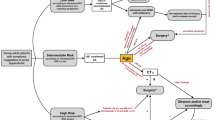Abstract
Objective. To examine features identified on US which predict success or failure of air-enema reduction of intussusception. Materials and methods. A retrospective study of 117 consecutive episodes of intussusception, presenting for US over a 6-year period. The specific features examined were: free fluid within the peritoneum, small-bowel obstruction, colonic wall thickness, and fluid trapped between the colon and the intussusceptum. Results. The overall reduction rate, irrespective of US features, over the 6-year period was 72 %. Reduction rates were significantly higher with the absence of free fluid, trapped fluid, or small-bowel obstruction (93 %). The presence of trapped fluid predicted an unfavourable outcome, with a significantly lower success rate (25 %). Colonic wall thickness did not predict outcome; in successful reductions, mean wall thickness was 7.2 mm and in failed reductions 7.6 mm. Conclusions. Where free fluid, small-bowel obstruction, and trapped fluid are absent, almost 100 % success with air-enema reduction should be achievable. Where trapped fluid is present, air enema should be performed cautiously to avoid perforation caused by overvigorous attempts at pneumatic reduction of an incarcerated intussusception.
Similar content being viewed by others
Author information
Authors and Affiliations
Additional information
Received: 5 August 1998 Accepted: 15 February 1999
Rights and permissions
About this article
Cite this article
Britton, I., Wilkinson, A. Ultrasound features of intussusception predicting outcome of air enema. Pediatric Radiology 29, 705–710 (1999). https://doi.org/10.1007/s002470050679
Issue Date:
DOI: https://doi.org/10.1007/s002470050679




